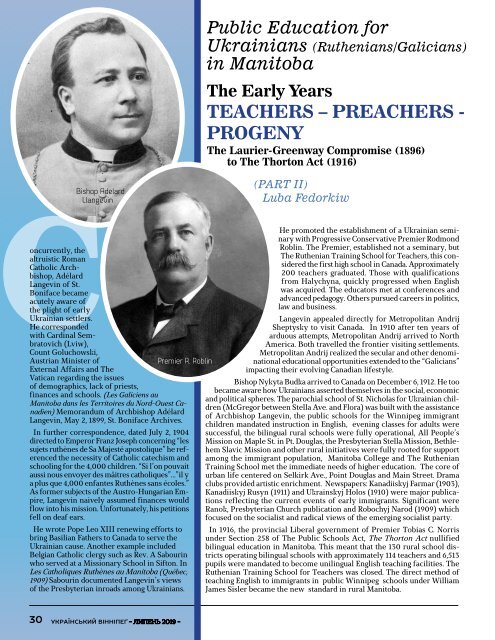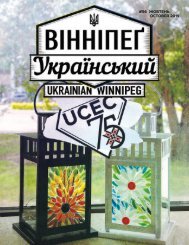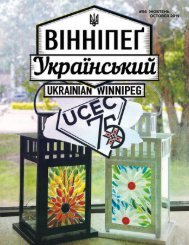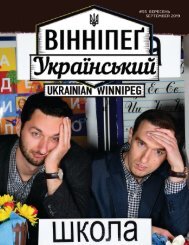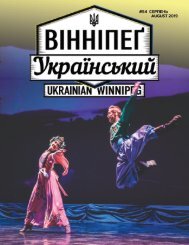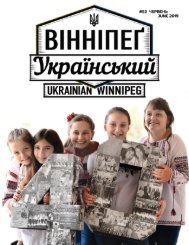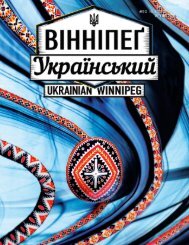Вінніпеґ Український № 7 (53) (July 2019)
You also want an ePaper? Increase the reach of your titles
YUMPU automatically turns print PDFs into web optimized ePapers that Google loves.
oncurrently, the<br />
altruistic Roman<br />
Catholic Archbishop,<br />
Adélard<br />
Langevin of St.<br />
Boniface became<br />
acutely aware of<br />
the plight of early<br />
Ukrainian settlers.<br />
He corresponded<br />
with Cardinal Sembratovich<br />
(Lviw),<br />
Count Goluchowski,<br />
Austrian Minister of<br />
External Affairs and The<br />
Vatican regarding the issues<br />
of demographics, lack of priests,<br />
finances and schools. (Les Galiciens au<br />
Manitoba dans les Territoires du Nord-Ouest Canadien)<br />
Memorandum of Archbishop Adélard<br />
Langevin, May 2, 1899, St. Boniface Archives.<br />
In further correspondence, dated <strong>July</strong> 2, 1904<br />
directed to Emperor Franz Joseph concerning “les<br />
sujets ruthènes de Sa Majesté apostolique” he referenced<br />
the necessity of Catholic catechism and<br />
schooling for the 4,000 children. “Si l’on pouvait<br />
aussi nous envoyer des mâitres catholiques”…”il y<br />
a plus que 4,000 enfantes Ruthènes sans écoles.”<br />
As former subjects of the Austro-Hungarian Empire,<br />
Langevin naively assumed finances would<br />
flow into his mission. Unfortunately, his petitions<br />
fell on deaf ears.<br />
He wrote Pope Leo XIII renewing efforts to<br />
bring Basilian Fathers to Canada to serve the<br />
Ukrainian cause. Another example included<br />
Belgian Catholic clergy such as Rev. A Sabourin<br />
who served at a Missionary School in Sifton. In<br />
Les Catholiques Ruthènes au Manitoba (Québec,<br />
1909) Sabourin documented Langevin’s views<br />
of the Presbyterian inroads among Ukrainians.<br />
Public Education for<br />
Ukrainians (Ruthenians/Galicians)<br />
in Manitoba<br />
The Early Years<br />
TEACHERS – PREACHERS -<br />
PROGENY<br />
The Laurier-Greenway Compromise (1896)<br />
to The Thorton Act (1916)<br />
(PART II)<br />
Luba Fedorkiw<br />
He promoted the establishment of a Ukrainian seminary<br />
with Progressive Conservative Premier Rodmond<br />
Roblin. The Premier, established not a seminary, but<br />
The Ruthenian Training School for Teachers, this considered<br />
the first high school in Canada. Approximately<br />
200 teachers graduated. Those with qualifications<br />
from Halychyna, quickly progressed when English<br />
was acquired. The educators met at conferences and<br />
advanced pedagogy. Others pursued careers in politics,<br />
law and business.<br />
Langevin appealed directly for Metropolitan Andrij<br />
Sheptysky to visit Canada. In 1910 after ten years of<br />
arduous attempts, Metropolitan Andrij arrived to North<br />
America. Both travelled the frontier visiting settlements.<br />
Metropolitan Andrij realized the secular and other denominational<br />
educational opportunities extended to the “Galicians”<br />
impacting their evolving Canadian lifestyle.<br />
Bishop Nykyta Budka arrived to Canada on December 6, 1912. He too<br />
became aware how Ukrainians asserted themselves in the social, economic<br />
and political spheres. The parochial school of St. Nicholas for Ukrainian children<br />
(McGregor between Stella Ave. and Flora) was built with the assistance<br />
of Archbishop Langevin, the public schools for the Winnipeg immigrant<br />
children mandated instruction in English, evening classes for adults were<br />
successful, the bilingual rural schools were fully operational, All People’s<br />
Mission on Maple St. in Pt. Douglas, the Presbyterian Stella Mission, Bethlehem<br />
Slavic Mission and other rural initiatives were fully rooted for support<br />
among the immigrant population, Manitoba College and The Ruthenian<br />
Training School met the immediate needs of higher education. The core of<br />
urban life centered on Selkirk Ave., Point Douglas and Main Street. Drama<br />
clubs provided artistic enrichment. Newspapers: Kanadiiskyj Farmar (1903),<br />
Kanadiiskyj Rusyn (1911) and Ukrainskyj Holos (1910) were major publications<br />
reflecting the current events of early immigrants. Significant were<br />
Ranok, Presbyterian Church publication and Robochyj Narod (1909) which<br />
focused on the socialist and radical views of the emerging socialist party.<br />
In 1916, the provincial Liberal government of Premier Tobias C. Norris<br />
under Section 258 of The Public Schools Act, The Thorton Act nullified<br />
bilingual education in Manitoba. This meant that the 130 rural school districts<br />
operating bilingual schools with approximately 114 teachers and 6,513<br />
pupils were mandated to become unilingual English teaching facilities. The<br />
Ruthenian Training School for Teachers was closed. The direct method of<br />
teaching English to immigrants in public Winnipeg schools under William<br />
James Sisler became the new standard in rural Manitoba.<br />
Bilingual teachers attended summer<br />
school professional training sessions at<br />
Strathcona School where they observed,<br />
practised and developed new educational<br />
strategies. By 1920, over 200 bilingual<br />
educators completed this training and<br />
William J. Sisler’s curriculum and materials<br />
assisted with the new educational<br />
direction.<br />
World War I (1914-18) precipitated antagonism<br />
and consequences for countless<br />
Ukrainians with Austro-Hungarian<br />
passports. Groundlessly, many were<br />
identified as disloyal or enemy aliens.<br />
Under the War Measures Act, Ukrainian<br />
newspapers were required to print<br />
parallel translation in English (bilingual)<br />
and suspected radical publications<br />
were banned. This sudden dynamic advanced<br />
alternate measures: vigilance<br />
in association, integration/assimilation<br />
through name changes to avoid targeting<br />
or discrimination, structuring new<br />
supplemental vehicles for linguistic and<br />
cultural integrity through ridni shkoly*,<br />
youth groups, choirs, dance ensembles,<br />
chytalyni, the Sheptyckyj “bursa (hostel)<br />
in St. Boniface for rural students (1917-<br />
20) and many more.<br />
In Iwasko and Kazymyra’s Jubilee Book<br />
of Ukrainian Catholics in Saskatchewan,<br />
pp.135-6, noted: “after his fifteen-year<br />
tenure in Canada (1912-27), Bishop<br />
Nykyta Budka left behind fourty-seven<br />
clergy, two hundred and ninety-nine parishes<br />
and missions, twenty six evening<br />
schools*, five parochial schools and five<br />
orphanages. During his tenure in Canada,<br />
he became well acquainted with local<br />
politicians, educators and business people.<br />
He witnessed both the achievements<br />
and failures of his people, issues related<br />
to public education, disenfranchisement<br />
Sources:<br />
Bilash, Borislaw N. Bilingual Public Schools in Manitoba 1897-1916. Winnipeg: Ukrainian<br />
Education Services, 1960,1970<br />
Bodrug, John, Independent Orthodox Church: Memoirs Pertaining to the History of a<br />
Ukrainian Church in the Years 1903-1913 (Toronto: Ukrainian Research Foundation, 1982)<br />
Czumer, Wm. A., Recollections About the Life of the First Ukrainian Settlers in Canada,<br />
(Edmonton: CIUS,1981)<br />
Gregor,Alexander and Wilson Keith, The Development of Education in Manitoba,<br />
(Dubuque, Iowa: Kendall/Hunt Publishing Co., 1984)<br />
Lehr,John, C. and Brian McGregor, The Geography of Bilingual Schools in Manitoba:<br />
Manitoba History 61 (Fall 2009)<br />
Maciejko, Bill, “Ukrainian and Prairie School Reform,1896-1921” Canadian Ethnic Studies 22 no. 2 (1990)<br />
Martynowych,O.T. Ukrainians in Canada: The Formative Period, 1891-1924 (Edmonton:<br />
CIUS Press,1991)<br />
Rozumnyj,Jaroslav: New Soil-Old Roots: The Ukrainian Experience in Canada (Winnipeg:<br />
Ukrainian Academy of Arts and Sciences in Canada, 1983)<br />
Shack,Sybil, “The Education of Immigrant Children During the First Two Decades of This<br />
Century,” Transactions of the Historical and Scientific Society of Manitoba, Series III (1973-<br />
74). Stataues of Manitoba<br />
Yuzyk, Paul, The Ukrainians in Manitoba: A Social History (Toronto: University of Toronto<br />
Press, 19<strong>53</strong>) (Multiple original and secondary sources through Public Archive Library and<br />
University of Manitoba Library)<br />
under the War Measures Act and internment<br />
operations.<br />
In May, 1919, just 23 days prior to The Winnipeg<br />
Strike, The Manitoba Teacher Federation<br />
was established. It recorded 650 paid<br />
teacher members in Manitoba. The original<br />
rolls (archived) were destroyed by the Winnipeg<br />
Flood of 1950. Indeed, it would have<br />
been interesting to review the Ukrainian surnames.<br />
In M.T.F. Bulletin, October, 1923 issue<br />
headed The New Canadian Problem by Alfred<br />
White, he noted that 17% of Manitoba’s population<br />
was Ruthenians. He focused on the<br />
resistance of trustees of rural districts to engage<br />
English speaking teachers, perpetuating<br />
support for their own language and culture<br />
and the weakened position of the provincial<br />
government to handle such a situation.<br />
Clearly, education for their children was of<br />
prime importance to early Ukrainian immigrants.<br />
They viewed it as a means to success.<br />
The bilingual system met the immediate<br />
need in rural Manitoba where children<br />
were taught in their maternal language, no<br />
different from the French or Mennonites.<br />
Whether secular or denominational, objective<br />
reflection upon the choices made in the<br />
formative years, framed by the political and<br />
social circumstances of that time, definitely<br />
allowed the teachers, preachers and progeny<br />
to be the recipients of the advantages of The<br />
Laurier-Greenway Compromise and scaffold<br />
forward the yet unknown concept of Canadian<br />
multiculturalism. Czumer, W.A. said it<br />
well: “just as the work of our pioneers on<br />
the farm was not wasted, so also the work of<br />
those first Ukrainian-English teachers. It has<br />
been crowned with great success.”<br />
Parallel with rural bilingual opportunities,<br />
unilingual education for immigrant children<br />
in urban Winnipeg public schools carved its<br />
own niche. Both met their developmental<br />
purpose - to educate productive minds. УВ<br />
30 <strong>Український</strong> <strong>Вінніпеґ</strong> - ЛИПЕНЬ <strong>2019</strong> -<br />
- JULY <strong>2019</strong> - UKRAINIAN WINNIPEG 31


